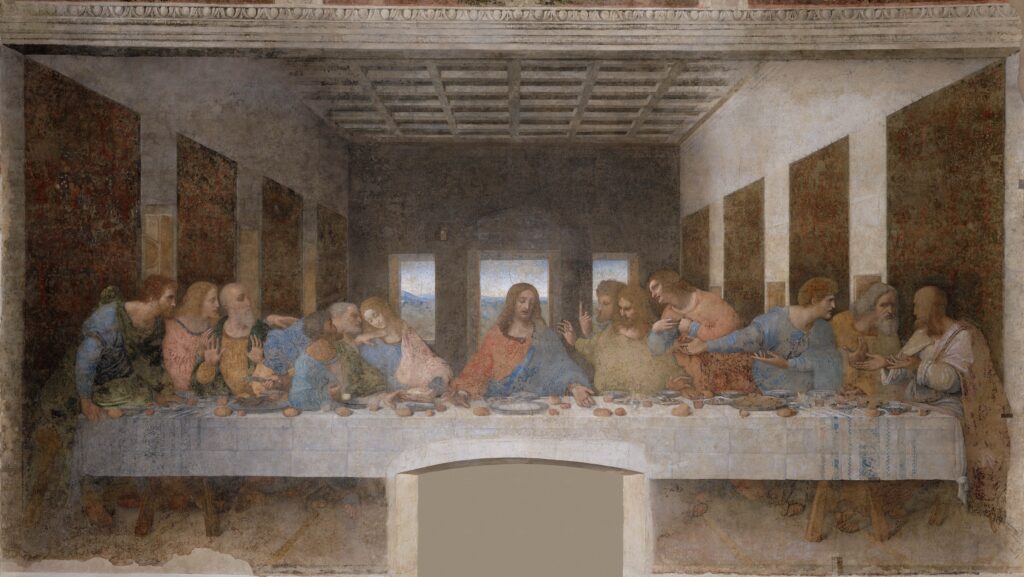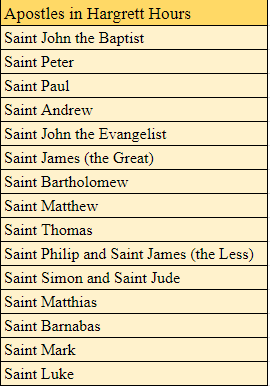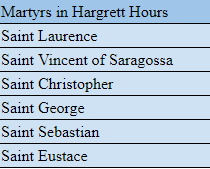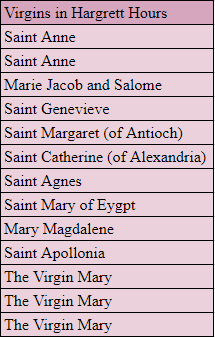Calling All Saints! The Lineup of the Hargrett Hours
Written in Fall 2023 by Grace Deaton, Kristina Durkin, Rachel Menikoff, and Anya Ricketson for Team Suffrages 4.0. Original translations by Zack Dow.
Edited in Spring 2024 by Grace Deaton for Hargrett Hours 4.1
Intro
Saints formed a distinctive part of Chrisitan devotion in the medieval period. Saints gained recognition from the Church as being exceptionally holy during their life and capable of producing miracles and acting as intercessors. A wide variety of saints existed for people to choose to venerate, ranging from biblical figures, regional saints, and patron saints of extremely specific illnesses; these interests vary from person to person. This variety can be seen in the suffrages in a Book of Hours, and the Hargrett Hours is a particularly good example.
A suffrage is a four-part commemoration of a saint or holy figure derived from “minor liturgical observance[s]” for saints found in breviaries (Anderson 162).. It consists of an antiphon or hymn; a versicle and response; and a prayer, called an oratio. Many suffrage collections also include a miniature for each saint. The texts (including the miniature) of the suffrage typically reference some aspect of the saint’s life, as recorded in the Bible or in their hagiography. The petition part of the suffrage appears in the versicle and response and at the end of the oratio. The suffrages section of a Book of Hours was highly customizable, since the commissioner would choose which saints to include. The organization of saints in the suffrages section usually does not change. The category of saint decides the order: apostle, martyr, confessor, or virgin.
The Hargrett Hours contains an extensive list of saints in its suffrages. A typical Book of Hours will contain about 12 suffrages, while the Hargrett Hours contains 46, including prayers to the Trinity and the Virgin Mary. Through the number of saints alone, it is clear that the owner had a particular interest in saints. Research into the individual saints can reveal the owner’s devotional interest.
Apostles
Apostles are male saints that appear in the Bible and (typically) knew Christ directly. The Hargrett Hours contains fifteen suffrages to seventeen apostles, making it the largest section of the suffrages.
The suffrages for the apostles have the opportunity to quote or reference Biblical passages, rather than being derived from hagiographical texts. For example, the antiphon for Saint Peter, who is one of the most common saints to find in a Book of Hours references the Gospels. It reads “You are the lead shepherd of all the apostles. The keys to the kingdom of heaven have been handed down to you” (f. 61v). This text refers to the passage from the gospel of Matthew where Jesus tells Peter “And I will give to thee the keys of the kingdom of heaven” (Matthew 16:19 (Douay-Rheims Bible). The text of the antiphon reflects Peter’s biblical depictions, as opposed to aspects unique to his legend, where he is considered the leader of the Disciples. The keys in this passage contribute to the perception of Peter as the gatekeeper of heaven; in religious art, Peter is often identified by these keys. The oratio expands this image when the prayer asks that God “grant that by the aid of his (Peter’s) intercession we may be freed from the binds of our sins” (f.61v-62v). This request extends the image of the keys: no longer just the keys to heaven, they are now also a key to unlock the chains of sin.
However, the Hargrett Hours does not always reference biblical depictions of the apostles. For example, St. Andrew is depicted in the Bible as being the brother of Peter and present at the feeding of the five thousand (Farmer 21). His antiphon reads:
Andrew, good doctor and friend of God, was led to the cross, seeing it from far away and spoke: O good cross which was desired for so long, and which was prepared for the eagerly desirous soul – take up the disciple of he who hung on you. (f. 62v)
This text references the hagiographic legend of Andrew in The Golden Legend, which helped standardize hagiographical narratives of common saints. In The Golden Legend, Andrew is crucified on an X-shaped cross. While he is being brought out, he sees a vision of Jesus’ cross and cries out a prayer titled “O Good Cross,” which is paraphrased in the Hargrett Hours antiphon. Most of the other apostles’ suffrages reference hagiographical texts rather than the Bible, giving priority to the way these saints are interpreted in hagiography, rather than in the Bible.
Martyrs
Martyrs are men who died in the name of Christ and were memorialized in the hearts, and manuscripts, of the people. As with the apostles, only male saints fall into this category. The Hargrett Hours contains six martyrs and seven suffrages. These martyrs are all found fairly often in Parisian Books of Hours, with the exception of Eustace who only appeared in six manuscripts in a survey of 60 Parisian Books of Hours undertaken in Spring 2024. The Hargrett Hours’ suffrage to All Martyrs is less common, but an important aid to the organization of the suffrage section.
While all these martyrs died in the name of Christ, some are memorialized due to specific good works and courageous acts. Laurence’s antiphon reads “Lawrence wrought a good work, in that with the sign of the Cross he gave sight to the blind” (f. 69r). Laurence’s miraculous works of giving sight to the blind with his cross is seen in medieval art where he is depicted carrying a cross (Farmer 295-296). Saint Christopher also performed a courageous act; he unknowingly carried Christ across a river. His antiphon reads “I pray to you through the name of Christ, your creator, whom you fortunately received the privilege of carrying on your shoulders” (f.70v). After failing to make a sacrifice to pagan gods, Christopher was imprisoned, beaten, shot with arrows, and later killed (Farmer 100-101). Saint George is a popular saint even in western culture today. He is known for the story of George and the Dragon, where he rid a town of a dragon in exchange for them believing in Jesus Christ. He was the personification of Christian chivalry (Farmer 202-203).
While Saint Vincent of Saragossa, Saint Sebastian and Saint Eustace are not legendary for a specific action, they are memorialized for their devotion to Christ unto the point of death. Vincent of Saragossa was a deacon and martyr of Spain. He was persecuted through Diocletian and Maximan and was imprisoned, weakened, racked, set in stocks, and eventually killed by being roasted on a gridiron (Farmer 493). His antiphon highlights his faithfulness to Christ: “Blessed Vincent, having been put to tortures, strengthened by the presence of God, with eager countenance, said, This is what I have always desired: and what I have sought with all my vows” (Renwick 86). Saint Sebastian is honored for his faithfulness on the battlefield and encouragement to other Christians. A section of his antiphon reads, “he who bore the marks of a soldier but was urged on by a palm from the brothers, greatly strengthened fearful hearts” (Gunhouse). Sebastian was a captain in Diocletian’s army. When Diocletian discovered Sebastian was a Christian, he ordered Sebastian to be shot to death with arrows. (Farmer 440-441). Finally, Saint Eustace is legendary. He is said to have been a Roman general who converted to Christianity after seeing a stag with the crucifix. He was roasted to death after refusing to sacrifice to pagan gods after a military battle (Farmer 176). All of these men are commended for their sacrifice for the Christian faith and memorialized in suffrages found in this manuscript and many others.
Confessors
After the martyrs follows the confessors. Confessors are “persons who lived a life of virtue but were not killed in the context of hatred of the Church,” as opposed to martyrs who died in service of Christ (McCleary). The Hargrett Hours contains five saints who are all relatively common in Books of Hours.
Two of the confessors may sound familiar to modern audiences: Saints Nicholas and Augustine of Hippo. To this day, Saint Nicholas is one of the most universally recognized saints. He is the inspiration for the modern day story of Santa Claus, based on his patronage of children and reputation as a gift giver. (Farmer 364-365). In the Hargrett Hours, Saint Nicholas’ prayer is relatively simple, asking that, through his prayers, God free the speaker from the fires of hell. It also notes his innumerable miracles. Saint Augustine of Hippo was a bishop and doctor of the church. He was born in Algeria to a pagan father and Christian mother. Though he was not baptized, he was raised a Christian and properly converted and was baptized later in life. Augustine’s writings remained influential across the Middle Ages, and some of them, like his De Civitate Dei and Confessions, are still commonly read today (Farmer 34-36).
The other three confessors are known as healers in their legends, but only Saint Anthony’s antiphon invokes healing. Saint Anthony was immensely popular in the middle ages and regarded as both a patriarch of monks and a healer of men and animals. Anthony’s oratio asks God to “grant that the diseaseful flames be extinguished and that rest can be furnished for our sick limbs” (fol. 73v.). These “diseaseful flames” are the effects of ergotism, which is a disease that comes from eating a fungus that could grow on rye. This disease affected Europeans from the sixth through late nineteenth centuries. For more information, check out this blog post!
The other two confessors were Saints Fiacre and Germain. Fiacre was an Irishman who fled to France in order to live a monastic life. He was the patron saint of gardeners and hemorrhoids; however, neither of these appear in his suffrage (Farmer 183). Instead, it calls him “the mirror of good deeds” without elaborating what these good deeds are. This is a good example of what a “stock suffrage” could look like. A stock suffrage is where someone wanted to include a saint in their suffrages, but the scribe did not have an exemplar with text unique to the saint. The final confessor is Saint Germain, also known as Germanus of Paris, who was born in Burgundy and educated at Avallon. He was notable for his interest in the saints, vigils at Saint Symphorien, and translations of relics. He was also a healer who cured the blind, epileptics, and possessed using oil, salt, bread and water (Farmer 206). Saint Germain’s suffrage in the Hargrett Hours notes that after he became a priest he did not consume bread or wine for taste, which lines up with his legend. It also asks for his intervention with God, since the speaker’s “voices do not deserve to be heard” (fols 75r-v).
Virgins
The final category of saints are the virgins. This is a catchall term for all female saints, regardless of their sexual history. However, typically these women’s sexualities do come up in their legends, which shows the medieval preoccupation with women’s “purity.” The Hargrett Hours contains thirteen suffrages to eleven individual virgins, which is notable because the virgins have more suffrages dedicated to them than martyrs and confessors combined.
The first category of female saints are the legendary female martyrs: Margaret of Antioch, Katherine of Alexandria, Agnes, Genevieve, and Apollonia. These women all suffered or died for their faith. Margaret, Katherine, and Agnes were punished by non-Christians due to their refusal of marriage or seduction as a test of their vow of virginity (Farmer 7-8, 29, 91-92, 327-328). Apollonia is unique in the Hargrett Hours because there is a leaf missing between folios 80v and 81r where her suffrage originally begin. Mounawar Abbouchi was able to identify the partial oratio at the beginning of fol. 81r as being a part of a suffrage to Apollonia.
The more significant subcategory are the Biblical and legendary Biblical figures. With the exception of Mary Magdalene, these women all belong to the Holy Kinship, the idea of Jesus’ earthly family. This includes the Virgin Mary, her mother Anne, and Mary’s half sisters Mary Jacob and Mary Salome. The Holy Kinship comes from medieval theologians trying to reconcile the conflict between Jesus having brothers and sisters in the Bible and the concern that the Virgin Mary remains perpetually a virgin (Dahood 229). The Hargrett Hours places special emphasis on these women, particularly Anne and the Virgin Mary. Anne is the only saint in the Hargrett Hours to have two full suffrages, and the Virgin Mary has two French prayers following her suffrage.
Along with the members of the Holy Kinship, the biblical women include Mary Magdalene, who was an extremely popular saint in Books of Hours. In the Bible, Mary Magdalene is the woman who had seven devils cast out of her by Jesus. However, she also became identified as Mary of Bethany, the sister of Martha and Lazarus, and the unnamed prostitute who washed Jesus’ feet (Reames). This connects her with Mary of Egypt who, although not biblical, was another reformed prostitute. Her legend states that she was a prostitute for seventeen years until she received a vision from the Virgin Mary to abandon that life and live in the desert. Mary did this and as a reward her virginity was restored (Farmer 339-340). She was also extremely uncommon in Books of Hours, only appearing in four out of sixty Parisian Books of Hours. For more about the connection between these women, check out this blog post.
Diagnostic Saints
Although every saint in the Hargrett Hours is an important part of the puzzle of the owner, there are several subsects of saints that can tell us more about either the devotional practices of the owner or where they were from.

The Last Supper by Leonardo da Vinci. High resolution scan by http://www.haltadefinizione.com/ in collaboration with the Italian ministry of culture. Scan details, Public Domain, https://commons.wikimedia.org/w/index.php?curid=3032252
The first group is the Twelve Disciples, who were Jesus’ closest followers in the Gospels and the ones who continued Jesus’ ministry after his death. All these men were relatively common in Books of Hours; however, it was not common to have all twelve in the suffrages. In a survey of sixty Parisian Book of Hours undertaken in Spring 2024, only four manuscripts contained all Twelve Disciples, including the Hargrett Hours. The other three are: Bodleian Library Bodleian Ms. Rawlinson Liturgical. e. 29, an early fifteenth century Book of Hours that is stripped of most of its decoration; Bodleian Library MS Douce 62, a highly decorated early fifteenth century Book of Hours containing the engravings of Henry de Lorreine and Charles de Lorraine; and Utopia, armarium codicum bibliophilorum Cod. 106, a high production quality mid-fifteenth century Book of Hours.
The presence of the Twelve Disciples also aligns with the members of the previously discussed Holy Kinship, demonstrating a deep interest in biblical figures. The combination of these two groups coincides with previous research done into the Passion. One of the conclusions was that the owner of the Hargrett Hours had a high degree of biblical literacy; as nearly half its saints are biblical figures, the suffrage section supports that conclusion. This set of saints in particular emphasizes Jesus’ earthly connections. These earthly connections make the events of the Passion even more moving, as the devotee has a deeper understanding of Jesus’ sacrifice.
The Hargrett Hours also contains three saints related to Northern France. Saints Germain and Genevieve are both patron saints of Paris; interestingly, neither is invoked in this role. Instead, Genevieve is invoked as a healer (for more info check out this blog post) and Germain’s suffrage references his fasting. Additionally, St. Fiacre, who was popular in northern France, appears in the confessor section (here’s another blog post on him). As previously noted, his suffrage is not particularly unique, so it’s unsurprising that it does not reference his Parisian connections. Nevertheless, all three saints appear frequently in Parisian Books of Hours, furthering the Hargrett Hours’ link to the French capital.
Conclusion
The suffrages of the Hargrett Hours demonstrate that the owner had niche devotional interest. In particular, the Twelve Disciples and the Biblical women show a clear biblical interest that coincides with the research done into the gospel passage from John and its focus on the Passion of Christ,, which suggests the owner had a high degree of biblical literacy. Devoting nearly half its space to saints who were biblical figures, the suffrage section confirms this, especially when the texts of the suffrages reference or come directly from the Bible.
References
Anderson, Michael Alan. Music and Performance in the Book of Hours. Routledge, 2022.
Dahood, Roger. “Ancrene Wisse and the Identities of Mary Salome.” A Companion to Ancrene Wisse, edited by Yoko Wada, D. S. Brewer, 2003, pp. 227–43.
Farmer, David Hugh. The Oxford Dictionary of Saints. Oxford University Press, 1997.
Harper, Sally. “Traces of Lost Late Medieval Offices? The Sanctilogium Angliae, Scotiae, et Hiberniae of John of Tynemouth (fl. 1350).” In Essays on the History of English Music in Honour of John Caldwell: Sources, Style, Performance, Historiography, edited by Emma Hornby and David Maw. Woodbridge, Suffolk: Boydell Press, 2010. 1-21.
Jacobus, de Voragine. The Golden Legend : Readings on the Saints. Princeton University Press, 2012.
“Listen to Laurentius Bonum Opus 8g – Vesp, Antiphona of Vesperas for S. Laurentii Diaconi – Fer 4, 10-08-2022.” Neumz, app.neumz.com/listen/vesperas-laurentius-bonum-opus-8g-vesp-164332/10-08-2022.
McCleary, Rachel M, and Robert J Barro. “Martyrs and Confessors.” AEA Meetings, Jan. 2022, https://doi.org/https://www.aeaweb.org/conference/2022/preliminary/paper/EfDeH8E3.
Naydenova-Slade, Mellie, and David Park. “The Earliest Holy Kinship Image, the Salomite Controversy, and a Little-Known Centre of Learning in Northern England in the Twelfth Century.” Journal of the Warburg and Courtauld Institutes, vol. 71, 2008, pp. 95–119. JSTOR, http://www.jstor.org/stable/20462778. Accessed 11 Dec. 2023.
Reames, Sherry L. “The Legend of Mary Magdelen, Penitent and Apostle: Introduction.” Middle English Legends of Women Saints. Medieval Institute Publications, Western Michigan University, 2003. https://d.lib.rochester.edu/teams/text/reames-middle-english-legends-of-women-saints-legend-of-mary-magdalen-introduction
Renwick, William. “The Sarum Rite : English Scholarly Breviary.” MacSphere, Gregorian Institute of Canada, 1 July 2014, macsphere.mcmaster.ca/handle/11375/16150.
Suffrage to Nicholas. “Suffrages.” Hypertext Book of Hours, Suffrages to the Saints, ed. and transl Glenn Gunhouse. 2019. medievalist.net/hourstxt/suffrage.htm#nicholas. .
Suffrage to Sebastian. “Suffrages.” Hypertext Book of Hours, Suffrages to the Saints, ed. and transl Glenn Gunhouse. 2019. medievalist.net/hourstxt/suffrage.htm#sebastian.



